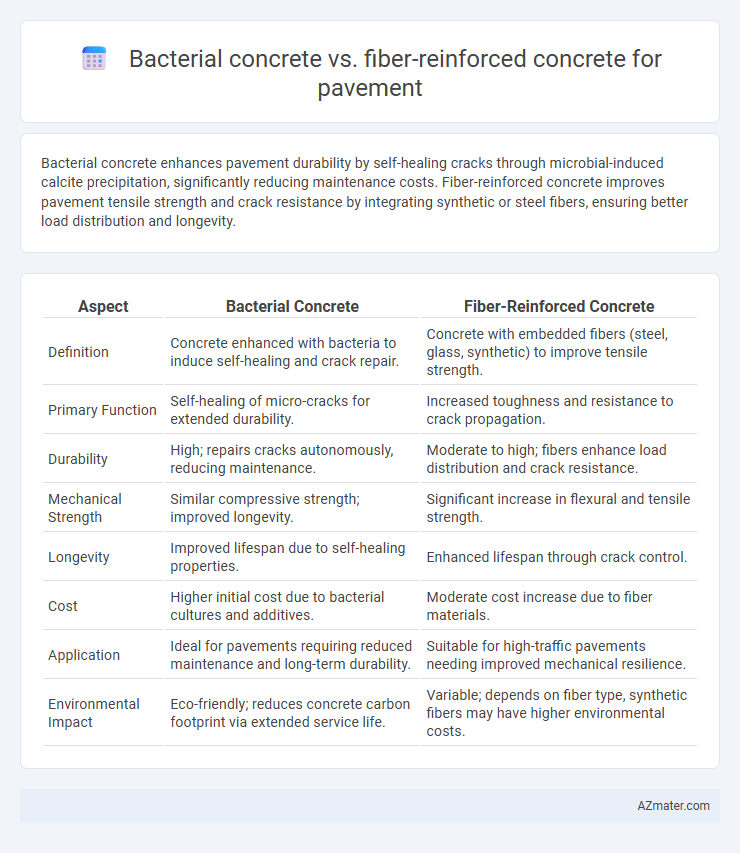Bacterial concrete enhances pavement durability by self-healing cracks through microbial-induced calcite precipitation, significantly reducing maintenance costs. Fiber-reinforced concrete improves pavement tensile strength and crack resistance by integrating synthetic or steel fibers, ensuring better load distribution and longevity.
Table of Comparison
| Aspect | Bacterial Concrete | Fiber-Reinforced Concrete |
|---|---|---|
| Definition | Concrete enhanced with bacteria to induce self-healing and crack repair. | Concrete with embedded fibers (steel, glass, synthetic) to improve tensile strength. |
| Primary Function | Self-healing of micro-cracks for extended durability. | Increased toughness and resistance to crack propagation. |
| Durability | High; repairs cracks autonomously, reducing maintenance. | Moderate to high; fibers enhance load distribution and crack resistance. |
| Mechanical Strength | Similar compressive strength; improved longevity. | Significant increase in flexural and tensile strength. |
| Longevity | Improved lifespan due to self-healing properties. | Enhanced lifespan through crack control. |
| Cost | Higher initial cost due to bacterial cultures and additives. | Moderate cost increase due to fiber materials. |
| Application | Ideal for pavements requiring reduced maintenance and long-term durability. | Suitable for high-traffic pavements needing improved mechanical resilience. |
| Environmental Impact | Eco-friendly; reduces concrete carbon footprint via extended service life. | Variable; depends on fiber type, synthetic fibers may have higher environmental costs. |
Introduction to Innovative Pavement Materials
Bacterial concrete incorporates specific bacteria to precipitate calcium carbonate, enhancing self-healing properties and durability in pavement applications by sealing cracks and reducing maintenance costs. Fiber-reinforced concrete integrates materials such as steel, glass, or synthetic fibers, improving tensile strength, toughness, and resistance to cracking under dynamic loads in pavements. Both innovative materials aim to extend pavement lifespan and performance, addressing challenges of traditional concrete through bio-based healing or mechanical reinforcement mechanisms.
Overview of Bacterial Concrete
Bacterial concrete incorporates specific microorganisms that precipitate calcium carbonate, enhancing crack self-healing and durability in pavement applications. This bio-based technology improves resistance to environmental stressors and reduces maintenance costs compared to traditional materials. The use of bacteria in concrete promotes sustainability by lowering cement consumption and extending pavement lifespan.
Overview of Fiber-Reinforced Concrete
Fiber-reinforced concrete (FRC) integrates synthetic or steel fibers within the concrete matrix to enhance tensile strength, crack resistance, and durability, making it highly suitable for pavement applications. The fibers help distribute loads more evenly and reduce shrinkage-induced cracking, improving the lifespan and performance of pavements under heavy traffic and environmental stress. Compared to bacterial concrete, FRC provides immediate mechanical reinforcement without relying on microbial-induced calcium carbonate precipitation, ensuring predictable enhancement of pavement structural integrity.
Mechanisms of Crack Healing in Bacterial Concrete
Bacterial concrete utilizes microbial-induced calcite precipitation (MICP) to heal cracks by depositing calcium carbonate, effectively sealing micro and macro fractures in the pavement structure and enhancing durability. Unlike fiber-reinforced concrete that primarily controls crack propagation through mechanical bridging by fibers such as steel or synthetic materials, bacterial concrete actively promotes bio-mineralization to restore the integrity of damaged areas. This self-healing mechanism in bacterial concrete reduces permeability and prevents further ingress of harmful agents, significantly extending the pavement lifespan compared to conventional fiber-reinforced alternatives.
Strength and Durability of Fiber-Reinforced Concrete
Fiber-reinforced concrete demonstrates superior tensile strength and crack resistance compared to bacterial concrete, making it more reliable for pavement applications that demand structural integrity. The inclusion of fibers enhances durability by preventing crack propagation and improving resistance to fatigue, freeze-thaw cycles, and abrasion. These attributes contribute to longer pavement service life and reduced maintenance costs compared to conventional bacterial concrete alternatives.
Comparative Performance Under Load and Stress
Bacterial concrete exhibits superior self-healing properties and enhanced crack resistance under load due to microbial-induced calcite precipitation, which improves durability and reduces maintenance for pavement applications. Fiber-reinforced concrete, incorporating synthetic or steel fibers, offers increased tensile strength and toughness, effectively controlling crack propagation and enhancing load-bearing capacity under stress. Comparative performance analysis shows bacterial concrete excels in long-term durability and sustainability, whereas fiber-reinforced concrete provides higher immediate structural resilience and impact resistance for pavements.
Resistance to Environmental Factors
Bacterial concrete exhibits superior resistance to environmental factors through self-healing properties that repair micro-cracks caused by weathering and chemical attacks, extending pavement durability. Fiber-reinforced concrete enhances resistance by distributing tensile stresses and reducing crack propagation, thereby improving performance under freeze-thaw cycles and temperature fluctuations. Both materials improve pavement longevity, but bacterial concrete offers a proactive approach by biologically sealing damage, while fiber-reinforced concrete provides mechanical reinforcement against environmental stressors.
Cost Analysis and Economic Viability
Bacterial concrete offers long-term cost savings in pavement projects by enhancing self-healing properties, reducing maintenance and extending service life, though its initial material costs are higher compared to fiber-reinforced concrete. Fiber-reinforced concrete provides improved tensile strength and crack resistance at a relatively lower upfront cost, leading to immediate economic advantages for short to medium-term pavement applications. Economic viability depends on project lifespan and maintenance budgets, with bacterial concrete favored for infrastructure requiring durability and reduced life-cycle costs, while fiber-reinforced concrete suits budget-conscious, shorter-term pavement solutions.
Sustainability and Environmental Impact
Bacterial concrete enhances pavement sustainability by reducing carbon dioxide emissions through microbial-induced calcium carbonate precipitation, promoting self-healing properties that extend pavement lifespan and reduce maintenance frequency. Fiber-reinforced concrete improves durability and crack resistance, thereby lowering repair needs and resource consumption, but its environmental benefits are limited by the production impacts of synthetic fibers. Bacterial concrete offers a more sustainable solution by actively reducing environmental degradation, whereas fiber-reinforced concrete primarily enhances mechanical performance with moderate ecological advantages.
Future Prospects and Recommendations
Bacterial concrete offers innovative self-healing properties that significantly enhance pavement durability by reducing micro-crack formation and maintenance costs, positioning it as a sustainable solution for future infrastructure. Fiber-reinforced concrete improves tensile strength and crack resistance, making it ideal for heavy traffic pavements requiring immediate load-bearing capacity and extended service life. Future research should focus on optimizing bacterial strain efficiency and fiber types to balance cost, performance, and environmental impact for large-scale pavement applications.

Infographic: Bacterial concrete vs Fiber-reinforced concrete for Pavement
 azmater.com
azmater.com